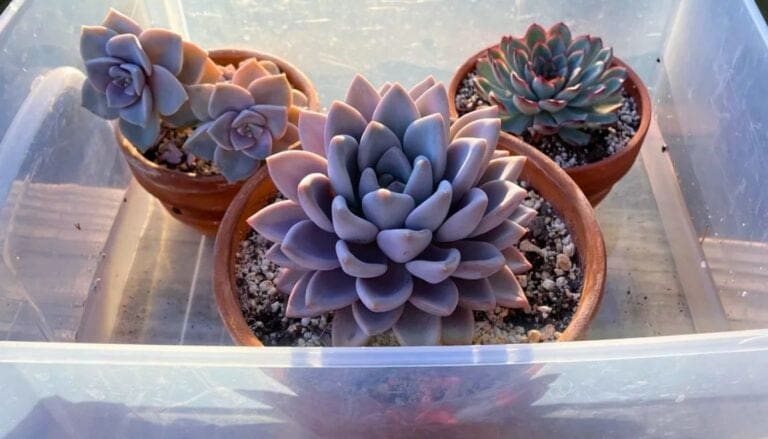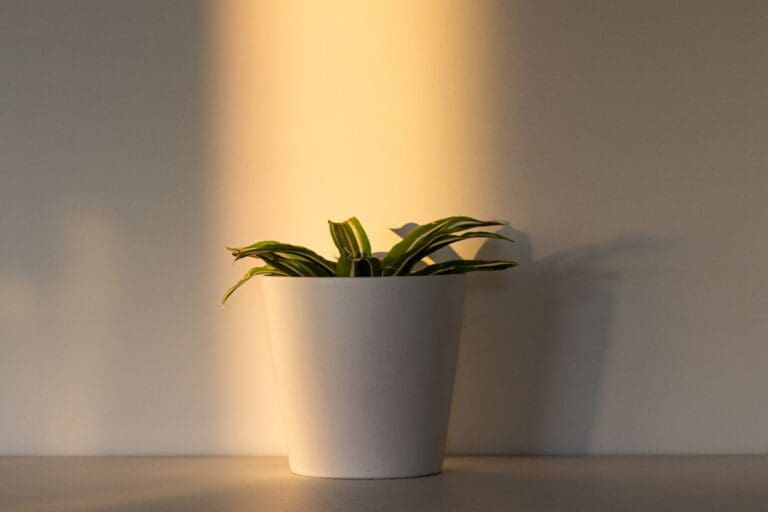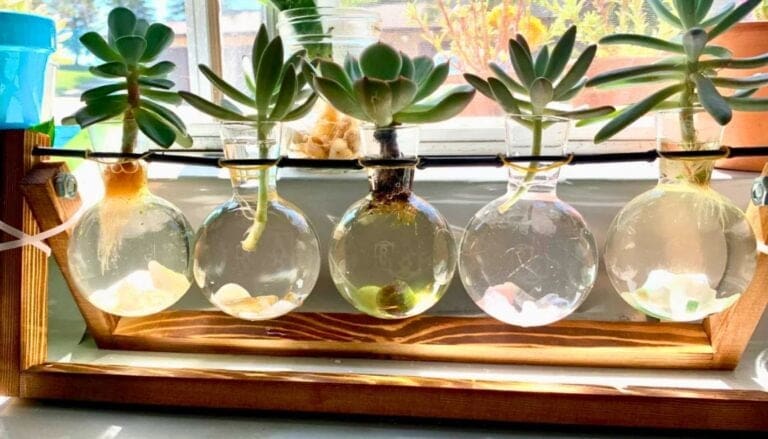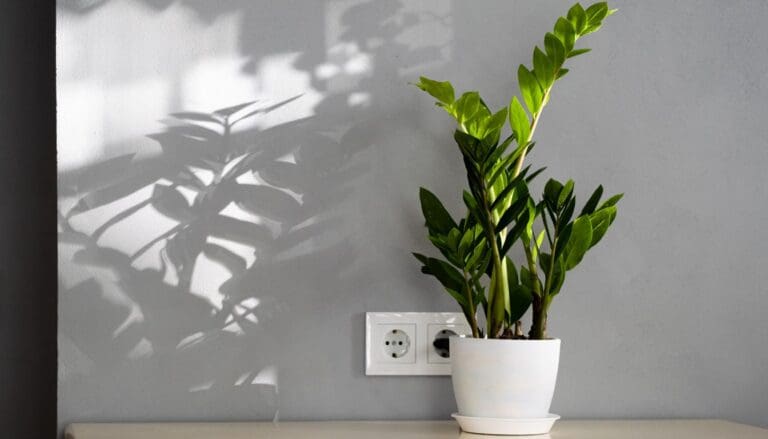Kalanchoe Plant Care: Top Tips for Thriving Greenery
Who knew taking care of a Kalanchoe plant could be so satisfying? These lovely succulents bring a pop of color and charm to any indoor space.
From their vibrant blooms to their low-maintenance nature, Kalanchoe plants are perfect for both newbie and seasoned plant lovers.
Place your Kalanchoe in a bright spot with indirect light to keep it thriving.
Whether it’s on your windowsill or a sunny corner, your plant will love soaking up the light.
Remember, too much direct sunlight can be harsh, just like it would be for us on a scorching day! 🌞
Want to know the secret to not overwatering? Let your Kalanchoe dry out completely between waterings.
This keeps the roots healthy and avoids the dreaded root rot.
Have you had any mishaps with overwatering before? Share your stories in the comments! 🌿
Please note: Simplify Plants is reader-supported. As an Amazon Associate, I earn from qualifying purchases made by our readers with no extra cost added to you all! Some links in the post are affiliate links and I get a commission from purchases made through links in the post.
Kalanchoe Basics
Let’s dive into a few key points about Kalanchoe plants, from their botanical features to some popular varieties you might love to grow indoors.
Botanical Profile
Kalanchoe plants are part of the succulent family. These plants are incredibly resilient and store water in their thick leaves, making them perfect for those who might forget to water regularly. 🌵
Scientific Name: Kalanchoe spp.
Kalanchoes are native to Madagascar and can grow in tough conditions.
The leaves are often smooth and waxy, and these plants produce vibrant flowers in various colors, including red, pink, yellow, and orange.
To thrive, these plants prefer bright, indirect sunlight and well-draining soil.
They can adapt to a variety of indoor settings, and I find they do best with a mix of succulent soil and standard potting mix.
Water sparingly and ensure the soil dries out completely between waterings.
Popular Varieties

There are several Kalanchoe varieties you might want to try growing at home. Each has its unique charm! 🌺
- Kalanchoe blossfeldiana: This is one of the most common types. It has bright, clustered flowers and is known for its long bloom period.
- Kalanchoe tomentosa: Also known as Panda Plant, it has fuzzy, silver leaves with brownish edges.
- Kalanchoe pinnata: Known for its medicinal properties, this variety has large, green leaves and is sometimes called the “Miracle Leaf” due to its many uses in traditional medicine.
Which Kalanchoe variety catches your eye? 🌿 Let me know in the comments below and share your experiences with growing these lovely plants indoors!
Optimal Growing Conditions
When growing a kalanchoe plant indoors, you’ll want to focus on providing the right light, temperature, humidity levels, and a proper watering schedule. These factors are key to keeping your kalanchoe healthy and blooming beautifully.
Light Requirements
Kalanchoe plants love light! They thrive in bright, indirect sunlight.
Place your kalanchoe near a window where it can get plenty of light but not direct sun, which can scorch its leaves.
If your home doesn’t get much natural light, consider using a grow light.
Do you have trouble finding a sunny spot? Rotating the plant every few days helps it grow evenly.
And if your plant’s leaves are looking pale or stretching, it means they need more light. 🌞
Temperature and Humidity
Kalanchoe plants prefer moderate temperatures.
They do best in rooms where the temperature stays between 60 to 85 degrees Fahrenheit (15.5 to 29 Celsius).
Try to avoid placing them in drafty areas or near heat sources like radiators.
Humidity is another factor. These plants like it on the drier side, with a humidity level of 40% to 60%.
Avoid high humidity areas like bathrooms.
Do you use a humidifier? Keep it away from your kalanchoe to prevent too much moisture.
Watering Schedule
When it comes to watering, less is more with kalanchoe plants.
Always wait for the top 1-2 inches of soil to dry out before watering again. Overwatering can lead to root rot, which is a big no-no! 💧
I water my kalanchoe about once every two weeks, but it can depend on the season and humidity in your home.
Use a pot with drainage holes to help avoid waterlogging.
And remember, too dry is better than too wet! If in doubt, skip a watering and check again in a few days.
Planting and Repotting

Getting your kalanchoe plant set up properly involves choosing the right soil, selecting a suitable pot, and following some simple steps to repot it regularly. 🌱
Soil Composition
Kalanchoe plants like well-draining soil.
The perfect mix for indoor plants includes 60% peat moss and 40% perlite. This blend helps balance drainage and moisture, so your plant doesn’t get too dry or too soggy.
You can also use a succulent mix or regular sandy potting soil.
Imagine giving your kalanchoe a dreamy, sandy beach to live on! 🏖️ It’ll thrive and bloom beautifully if you get the soil just right.
Choosing the Right Pot
The pot you choose plays a big role in helping your kalanchoe grow.
Pick a pot that’s just a bit larger than the current one, with good drainage holes to prevent water from sitting at the bottom.
I love using clay or terracotta pots because they dry out quickly, which helps avoid root rot.
Isn’t it fun shopping for new pots? It’s like finding the perfect shoes for your plant! 👠
Repotting Steps
Repotting your kalanchoe every 1-2 years keeps it healthy and happy.
Ready to repot? Start by gently removing the plant from its current pot.
Loosen the old soil from the roots without pulling too hard.
Next, place the kalanchoe in the center of the new pot and fill in around it with fresh soil.
Tap the soil lightly to avoid air pockets but don’t pack it too tightly.
Finally, give your plant a good drink until the soil is moist, and place it near a sunny window.
Nutrition and Fertilization

Let’s dive into how to keep our Kalanchoe plants well-fed and thriving indoors. I’ll cover the types of fertilizers to use and how often to feed these beauties to keep them lush and vibrant. 🌱✨
Fertilizer Types
Kalanchoe plants aren’t too fussy, but they do appreciate a good meal!
I like to use a well-balanced fertilizer.
This means equal parts of nitrogen (N), phosphorus (P), and potassium (K), such as a 10-10-10 blend. You can find these at most garden centers or online.
Liquid fertilizers are super easy to mix with water and apply during regular watering.
For a more hands-off approach, granular fertilizers can be sprinkled on the soil. These release nutrients slowly over time, which is great for consistent growth.
Feeling fancy? Try foliar feeding – this involves spraying a diluted fertilizer directly onto the leaves.
Feeding Frequency
Timing is everything when it comes to feeding our Kalanchoe friends!
In the spring and summer, I feed my plants once a month.
They’re actively growing during these months, so they need the extra nutrients. 🔆
During fall and winter, I give them a break.
Kalanchoes enter a period of rest, so they don’t need as much food. Overfeeding during this time can actually harm them, so it’s best to skip it and let them chill out.
Pruning and Maintenance

Keeping your Kalanchoe looking fresh involves regular pruning and watching out for pests and diseases. Here’s how to make sure your plant stays in top shape! 🌿
Pruning Techniques
Pruning is a key part of keeping a Kalanchoe happy and healthy.
I usually trim my Kalanchoe in late winter, right before the blooming season kicks off.
Trim up to a third of each stem’s length to promote strong, new growth. Use clean, sharp scissors to make precise cuts.
Be careful not to chop off too much at once.
You can also remove any dead or wilting flowers to keep the plant looking fresh.
It’s like giving your plant a haircut—it helps it grow stronger and look tidier. ✂️🌸
Pest and Disease Management
Nobody wants pests or diseases crashing the party.
To keep your Kalanchoe pest-free, inspect the leaves regularly for bugs like aphids or mealybugs.
If I spot any, I gently wipe them off with a damp cloth. For stubborn pests, a mild solution of soap and water does the trick.
On the disease front, avoid overwatering.
Kalanchoe plants prefer their soil to dry out between waterings. Too much water can lead to root rot or fungal issues.
And remember, these plants like low humidity, so keep them away from overly humid spots in your home. 🏡🐞👀
Propagation Methods

Propagating kalanchoe plants is a fun and simple way to create new plants. You can easily propagate them using leaf cuttings or offsets. Each method has its unique steps and tips.
Leaf Cuttings
One of the neatest ways to grow new kalanchoe plants is by using leaf cuttings.
First, choose a healthy leaf from the parent plant. Make a clean cut at the base of the leaf.
Let the cut leaf sit for a few days until the cut end has dried out. This step is crucial to prevent rotting when it’s planted.
Next, prepare a pot with well-draining soil, like a mix of regular potting soil and cactus soil.
Place the leaf cutting on top of the soil, ensuring the cut end makes contact.
Lightly pat the soil around the leaf to keep it in place.
Place the pot in a spot with bright, indirect sunlight. Remember, too much direct sun can scorch the leaf.
Water the soil lightly, just enough to keep it moist but not soggy.
After a few weeks, you should see roots starting to form. It’s like a tiny miracle! 🌱
Keeping the leaf warm and in indirect light is key to successful growth. You’ll soon have a new, thriving kalanchoe plant.
Offsets
Offsets are another incredible way to propagate kalanchoe plants. These are small baby plants that grow next to the parent plant.
Look for offsets that are big enough to handle—typically a few inches tall.
Carefully remove the offset from the parent plant using a clean knife or scissors. Make sure to include some roots with the offset. This ensures it has a good start when you plant it.
If the offset has no roots, don’t worry—it can still grow them once planted.
Prepare a small pot with well-draining soil.
Plant the offset in the soil and gently pat it down to hold it in place.
Water it thoroughly and place the pot in a location with bright, indirect sunlight.
Just like with leaf cuttings, avoid direct sunlight to prevent damage.
Keep the soil lightly moist and watch your new kalanchoe baby grow! ❤️
Flowering and Aftercare

Kalanchoe plants are well-known for their beautiful blooms, and getting them to flower and taking care of them after is crucial. I’ll walk you through how to encourage those vibrant flowers and what to do once they have finished blooming.
Encouraging Blooms
To get Kalanchoe to bloom indoors, you need to mimic its natural conditions.
These plants thrive with plenty of light, so place them near a sunny window. They need around 6-8 hours of bright, indirect sunlight daily. 🌞
Temperature is also key. Aim to keep your indoor Kalanchoe at 17-20 degrees Celsius (64-68°F). They love these stable temps and will reward you with flowers.
For watering, let the soil dry out between waterings.
Stick your finger in the soil up to the first knuckle; if it feels dry, it’s time to water.
Be careful not to get water on the leaves, as that can cause blemishes. 💧
Don’t forget to fertilize! Use a well-balanced, liquid fertilizer for houseplants every two weeks during the growing season to encourage blooming.
Post-Flowering Care
Once your Kalanchoe has finished blooming, it’s not done yet!
First, trim off the dead flowers. This helps the plant redirect energy towards new growth rather than maintaining the old blooms.
Let the plant enjoy a resting period. This usually means less light and cooler temperatures than during the blooming phase.
Keep the humidity low and avoid overwatering to prevent rot.
During this resting period, continue to water sparingly.
Just make sure the soil doesn’t stay soggy.
Prune the plant if it becomes leggy to maintain a nice shape.
Would you like your Kalanchoe to bloom again? I got you!
Start exposing it to 14 hours of darkness per day for about 6 weeks. This simulates the natural environment that cues them to bloom again. 🌷
Troubleshooting Common Issues

Caring for a kalanchoe indoors can be rewarding, but sometimes issues arise. Let’s look at how to recognize and fix some common problems you might face.
Overwatering Symptoms
Overwatering is a frequent issue with kalanchoe plants.
When the plant gets too much water, you’ll notice yellowing leaves and mushy, soft stems. The roots might also start to rot.
I always check the soil moisture before watering.
Stick your finger an inch into the soil—if it’s dry, go ahead and water. If not, wait a bit. 🌱
Using well-draining soil and pots with drainage holes can also prevent overwatering. A moisture gauge can be handy if you’re unsure.
Light Issues
Kalanchoe needs the right amount of light to thrive.
Not enough light can lead to leggy growth and fewer flowers.
If your plant looks thin and stretched out, it’s probably not getting enough sunlight.
I place mine near a bright window but out of direct sunlight, which can scorch the leaves.
Aim for 6 hours of indirect light daily. If you notice it’s still struggling, consider using a grow light to supplement natural light.
Pest Infestations
Pests like aphids, mealybugs, and spider mites can sometimes trouble your kalanchoe.
These pests suck the sap from the plant, leading to yellowing leaves and stunted growth.
Inspect your plant regularly, especially under the leaves.
If you spot pests, you can wipe them off with a mixture of water and a few drops of dish soap.
I’ve found that neem oil is also effective.
Keep your kalanchoe clean and dust-free to discourage pests. 🚫🐜
FAQs
How often should I water my Kalanchoe?
Water your Kalanchoe when the top few inches of soil are dry. Be careful not to overwater. Too much water can cause root rot. You can check the soil by sticking your finger into it.
What type of soil is best for Kalanchoe plants?
Kalanchoes thrive in well-draining potting mix. I like to use a mix of succulent soil and sandy soil. This combination helps with drainage and keeps the roots happy.
Can Kalanchoe grow in low light?
Kalanchoe plants prefer bright, indirect light. If you keep them in low light, they might not bloom well. I always place my plant near a sunny window, but out of direct sunlight.
Do Kalanchoes need fertilizers?
Yes! For better blooms, feed your Kalanchoe a liquid organic fertilizer once a month during spring and summer. This helps the plant stay healthy and produce more flowers.
Is it normal for Kalanchoe leaves to turn yellow?
Yellow leaves might mean you’re overwatering your plant. Make sure the soil dries out between waterings. Sometimes, it could also be a sign of too little light.
Can I grow Kalanchoe outdoors?
Yes, but it’s mostly an indoor plant. If you want to take it outside, make sure it’s in a spot with full sun but protected from harsh afternoon sunlight. Don’t forget to bring it back inside before it gets too cold.
Do Kalanchoes like high humidity?
Kalanchoes prefer low to moderate humidity. Keeping them in a dry area of your home is key. High humidity can lead to problems like rot. So, avoid placing them in bathrooms or other humid places.
Do I need to prune my Kalanchoe?
Yes, occasional pruning helps. Trim off dead flowers and leaves to keep your plant looking nice and to encourage new growth.
Have more questions? Drop them in the comments! 🌿😊
Conclusion
Taking care of a kalanchoe plant indoors is pretty straightforward. 🌿 With the right care, these plants can thrive and brighten up your home.
First, place your kalanchoe in a spot with bright, indirect light. A sunny windowsill works great, as long as it doesn’t get harsh afternoon sun.
Next, make sure to use a well-draining potting mix. I like to use a blend of cactus mix or a succulent mix. This helps prevent root rot.
Watering is key. Let the soil dry out completely between waterings. When you do water, try to avoid splashing water on the leaves to keep them healthy and blemish-free.
Don’t forget about humidity. Kalanchoes prefer low to moderate humidity levels. High humidity can make them unhappy. So, keeping them in a dry area is ideal.
Lastly, give your kalanchoe some love with monthly feeding during the growing season. A liquid organic fertilizer works well and helps the plant produce vibrant blooms. 🌼
Recommended Garden Supplies
| Product Image | Our Recommended Gardening Supplies | Check Offers! |
|---|---|---|
Top Top
Top
Top
Top
Top
Top
Top
Top | rePotme Houseplant and Tropical Classic Potting Soil Mix | Check Offer On Amazon |
 Top
Top
Top
Top
Top
Top
Top
Top | Espoma Organic Indoor Plant Food | Check Offer On Amazon |
 Top
Top
Top
Top
Top
Top
Top
Top | GooingTop LED Grow Light 6000K Full Spectrum Clip Plant Growing Lamp | Check Offer On Amazon |
 Top
Top
Top
Top
Top
Top
Top
Top | Soil Moisture Meter | Check Offer On Amazon |
 Top
Top
Top
Top
Top
Top
Top
Top | Govee Hygrometer Thermometer, Bluetooth Enabled! | Check Offer On Amazon |
 Top
Top | LEVOIT Humidifiers for Large Room(Best For Plants) | Check Offer On Amazon |
 Top
Top
Top
Top
Top
Top
Top
Top | Upgraded DIY Automatic Drip Irrigation Kit, 15 Potted Houseplants Support | Check Offer On Amazon |
 Top
Top
Top
Top
Top
Top
Top
Top | Stainless Steel Heavy Duty Gardening Tool Set | Check Offer On Amazon |
 Top
Top
Top
Top
Top
Top
Top
Top | Bonide Insecticidal Soap | Check Offer On Amazon |
 Top
Top
Top
Top
Top
Top
Top
Top | Bonide 32 oz Spray Neem Oil for Organic Gardening | Check Offer On Amazon |
 Top
Top
Top
Top
Top
Top
Top
Top | Garden Safe Fungicide | Check Offer On Amazon |







